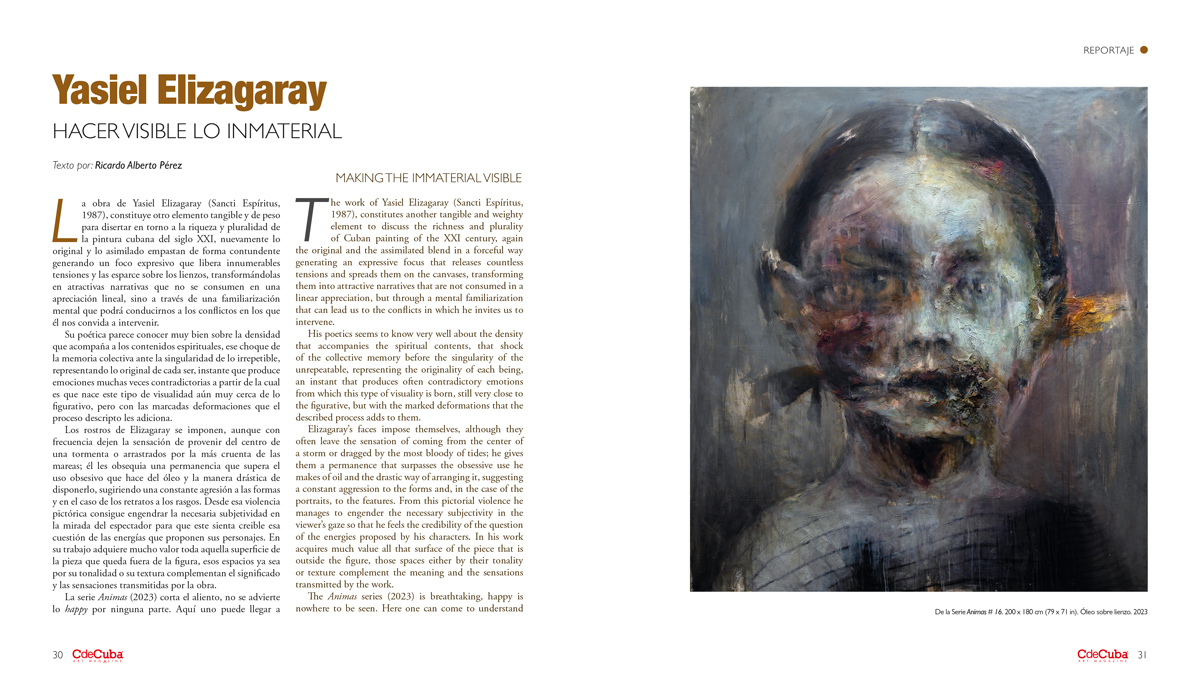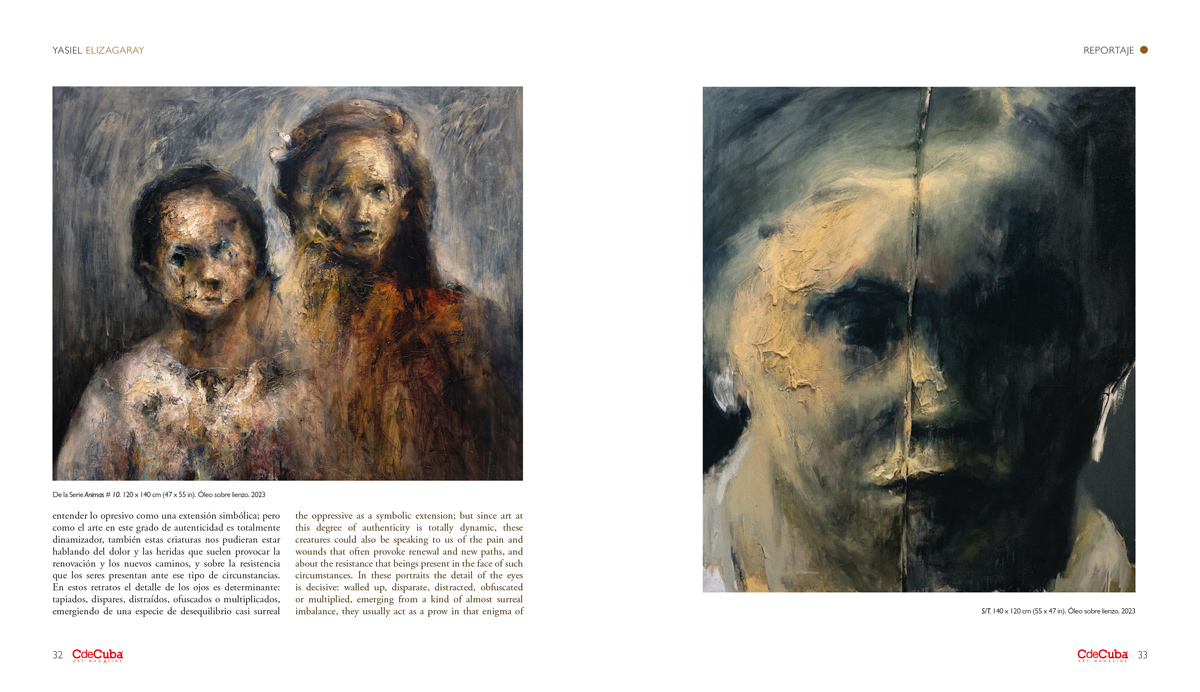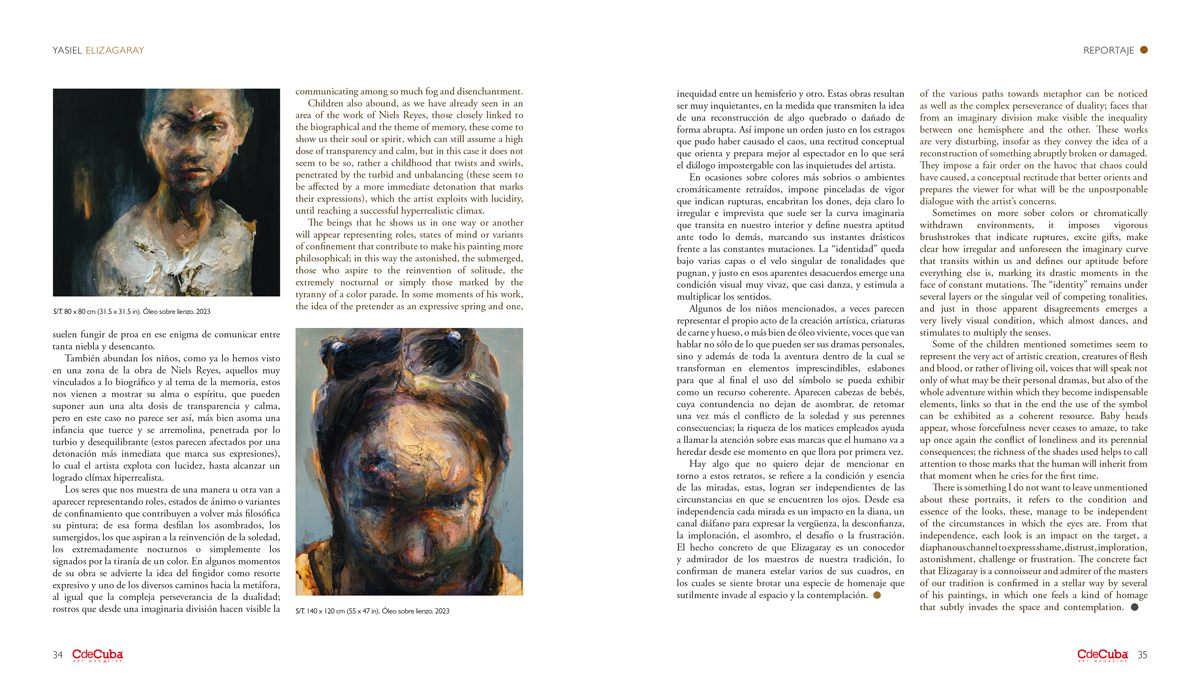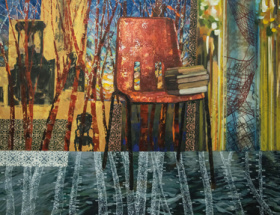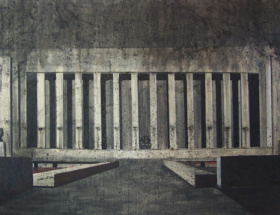Making the Immaterial Visible
By Ricardo Alberto Pérez
The work of Yasiel Elizagaray (Sancti Espíritus, 1987), constitutes another tangible and weighty element to discuss the richness and plurality of Cuban painting of the XXI century, again the original and the assimilated blend in a forceful way generating an expressive focus that releases countless tensions and spreads them on the canvases, transforming them into attractive narratives that are not consumed in a linear appreciation, but through a mental familiarization that can lead us to the conflicts in which he invites us to intervene.
His poetics seems to know very well about the density that accompanies the spiritual contents, that shock of the collective memory before the singularity of the unrepeatable, representing the originality of each being, an instant that produces often contradictory emotions from which this type of visuality is born, still very close to the figurative, but with the marked deformations that the described process adds to them.
Elizagaray’s faces impose themselves, although they often leave the sensation of coming from the center of a storm or dragged by the most bloody of tides; he gives them a permanence that surpasses the obsessive use he makes of oil and the drastic way of arranging it, suggesting a constant aggression to the forms and, in the case of the portraits, to the features. From this pictorial violence he manages to engender the necessary subjectivity in the viewer’s gaze so that he feels the credibility of the question of the energies proposed by his characters. In his work acquires much value all that surface of the piece that is outside the figure, those spaces either by their tonality or texture complement the meaning and the sensations transmitted by the work.
The Animas series (2023) is breathtaking, happy is nowhere to be seen. Here one can come to understand the oppressive as a symbolic extension; but since art at this degree of authenticity is totally dynamic, these creatures could also be speaking to us of the pain and wounds that often provoke renewal and new paths, and about the resistance that beings present in the face of such circumstances. In these portraits the detail of the eyes is decisive: walled up, disparate, distracted, obfuscated or multiplied, emerging from a kind of almost surreal imbalance, they usually act as a prow in that enigma of communicating among so much fog and disenchantment.
Children also abound, as we have already seen in an area of the work of Niels Reyes, those closely linked to the biographical and the theme of memory, these come to show us their soul or spirit, which can still assume a high dose of transparency and calm, but in this case it does not seem to be so, rather a childhood that twists and swirls, penetrated by the turbid and unbalancing (these seem to be affected by a more immediate detonation that marks their expressions), which the artist exploits with lucidity, until reaching a successful hyperrealistic climax.
The beings that he shows us in one way or another will appear representing roles, states of mind or variants of confinement that contribute to make his painting more philosophical; in this way the astonished, the submerged, those who aspire to the reinvention of solitude, the extremely nocturnal or simply those marked by the tyranny of a color parade. In some moments of his work, the idea of the pretender as an expressive spring and one, of the various paths towards metaphor can be noticed as well as the complex perseverance of duality; faces that from an imaginary division make visible the inequality between one hemisphere and the other. These works are very disturbing, insofar as they convey the idea of a reconstruction of something abruptly broken or damaged. They impose a fair order on the havoc that chaos could have caused, a conceptual rectitude that better orients and prepares the viewer for what will be the unpostponable dialogue with the artist’s concerns.
Sometimes on more sober colors or chromatically withdrawn environments, it imposes vigorous brushstrokes that indicate ruptures, excite gifts, make clear how irregular and unforeseen the imaginary curve that transits within us and defines our aptitude before everything else is, marking its drastic moments in the face of constant mutations. The “identity” remains under several layers or the singular veil of competing tonalities, and just in those apparent disagreements emerges a very lively visual condition, which almost dances, and stimulates to multiply the senses.
Some of the children mentioned sometimes seem to represent the very act of artistic creation, creatures of flesh and blood, or rather of living oil, voices that will speak not only of what may be their personal dramas, but also of the whole adventure within which they become indispensable elements, links so that in the end the use of the symbol can be exhibited as a coherent resource. Baby heads appear, whose forcefulness never ceases to amaze, to take up once again the conflict of loneliness and its perennial consequences; the richness of the shades used helps to call attention to those marks that the human will inherit from that moment when he cries for the first time.
There is something I do not want to leave unmentioned about these portraits, it refers to the condition and essence of the looks, these, manage to be independent of the circumstances in which the eyes are. From that independence, each look is an impact on the target, a diaphanous channel to express shame, distrust, imploration, astonishment, challenge or frustration. The concrete fact that Elizagaray is a connoisseur and admirer of the masters of our tradition is confirmed in a stellar way by several of his paintings, in which one feels a kind of homage that subtly invades the space and contemplation.
